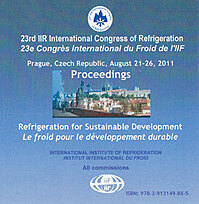
Document IIF
Une comparaison entre eau-bromure de lithium et liquide ionique-eau comme fluides actifs pour des cycles frigorifiques à absorption.
A comparison between lithium bromide-water and ionic liquid-water as working solution for absorption refrigeration cycles.
Numéro : pap. ID: 287
Auteurs : RÖMICH C., MERKEL N., SCHABER K., et al.
Résumé
Reliable vapour-liquid-equilibria (VLE) measurements are required for the estimation of the performance of an absorption chiller. Thus the water partial pressure of a mixture of water and a room temperature ionic liquid (RTIL) was measured in two different ways: Via Fourier-transform-infrared (FT-IR) Spectroscopy in a dynamic cell and via Raman-spectroscopy in a static cell. Additional mixture properties as viscosity and specific heat capacity were measured as a function of concentration. An absorption chiller designed for LiBr-water with a nominal cooling capacity of 10 kW was operated with a mixture of diethylmethylammonium methanesulfonate (DEMA MeSO3) and water in order to demonstrate the performance of new working solutions with RTILs. Although the measured coefficient of performance (COP) is comparable to the one of lithium bromide (LiBr)-water, the higher viscosities of working solutions with RTILs cause an insufficient heat and mass transfer which leads to a low refrigeration output.
Documents disponibles
Format PDF
Pages : 8 p.
Disponible
Prix public
20 €
Prix membre*
Gratuit
* meilleur tarif applicable selon le type d'adhésion (voir le détail des avantages des adhésions individuelles et collectives)
Détails
- Titre original : A comparison between lithium bromide-water and ionic liquid-water as working solution for absorption refrigeration cycles.
- Identifiant de la fiche : 30002421
- Langues : Anglais
- Source : Proceedings of the 23rd IIR International Congress of Refrigeration: Prague, Czech Republic, August 21-26, 2011. Overarching theme: Refrigeration for Sustainable Development.
- Date d'édition : 21/08/2011
Liens
Voir d'autres communications du même compte rendu (569)
Voir le compte rendu de la conférence
-
Energy and exergy analysis of H2O/Li...
- Auteurs : PRIETO J., AYOU D. S., CORONAS A.
- Date : 04/2022
- Langues : Anglais
- Source : XI Congreso Ibérico y IX Congreso Iberoamericano de Ciencias y Técnicas del Frío, CYTEF 2022.
- Formats : PDF
Voir la fiche
-
Second law analysis of multi-stage lithium brom...
- Auteurs : LEE S. F., SHERIF S. A.
- Date : 2000
- Langues : Anglais
- Source : ASHRAE Transactions. 2000 Winter Meeting, Dallas, Texas + CD-ROM.
Voir la fiche
-
A Gibbs energy equation for LiBr/H2O solutions.
- Auteurs : KIM D. S., INFANTE FERREIRA C. A.
- Date : 01/08/2004
- Langues : Anglais
- Source : Natural Working Fluids 2004: 6th IIR-Gustav Lorentzen Conference
- Formats : PDF
Voir la fiche
-
Second law analysis of a lithium bromide/water ...
- Auteurs : LEE S. F., SHERIF S. A.
- Date : 19/09/1999
- Langues : Anglais
- Source : 20th International Congress of Refrigeration: Refrigeration into the Third Millennium.
- Formats : PDF
Voir la fiche
-
Analiza opravdanosti primjene mikro-trigeneraci...
- Auteurs : BOZUNOVIC A., PRELEC Z., PAVKOVIC B.
- Date : 22/10/2008
- Langues : Serbo-croate
- Source : Energija i okolis 2008. Medunarodni kongres: XXI. znanstveni skup o energiji i zastiti ikolisa./ Energy and the environment 2008. International congress: 21th Scientific Conference on Energy and the Environment.
- Formats : PDF
Voir la fiche
